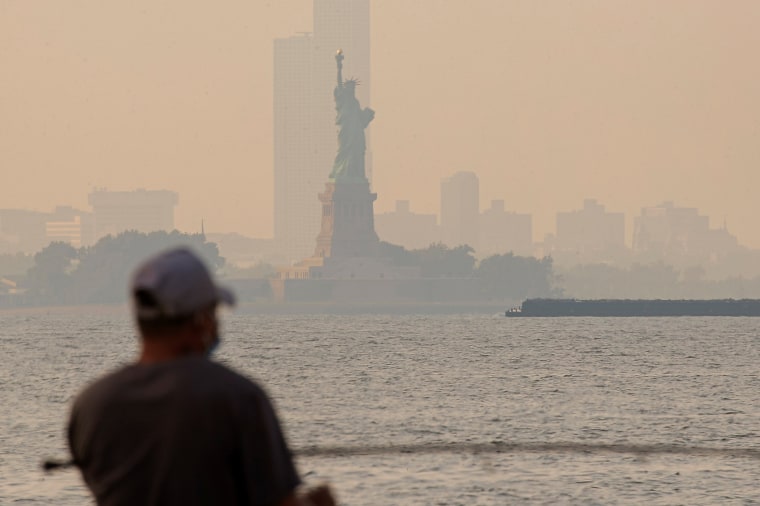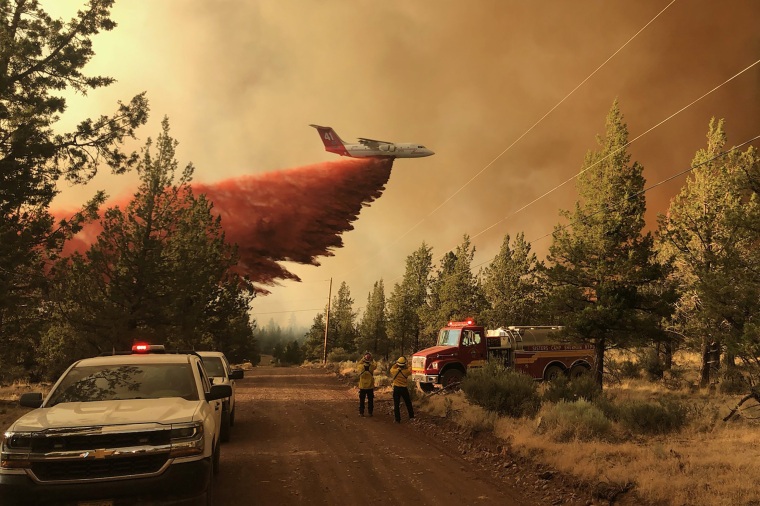The current space race isn’t just for billionaires.
Using satellites, drones and artificial intelligence, emerging technology is changing the way firefighting agencies and governments battle the ever-increasing threat of wildfires as hundreds of thousands of acres burn across the western United States.
New programs are being developed by startups and research institutions to predict fire behavior, monitor drought and even detect fires when they first start. As climate change continues to increase the intensity and frequency of wildfires, these breakthroughs offer at least one tool in the growing arsenal of prevention and suppression strategies.
“This is not to replace firefighting on the ground,” said Ilkay Altintas, a computer scientist with the University of California, San Diego, who developed a fire map for the region. “The more science and data we can give firefighters and the public, the quicker we’ll have solutions to combat and mitigate wildfires.”
More than 80 large fires and complexes have scorched more than 1.3 million acres across 13 states this year as of Friday, according to the National Interagency Fire Center, and additional fires are breaking out almost every week.
The country’s largest inferno, the Bootleg Fire in southern Oregon, has forced thousands of residents to evacuate since lightning sparked it July 6. Smoke from the Western blazes is so thick that East Coast residents were treated this week to a spectacular, if worrisome, fiery sunrise and hazy skies.

“As the risk for catastrophic wildfire grows, so should our ability to forecast wildfires and to mitigate fire risk,” Rep. Zoe Lofgren, D-Calif., said last month during a House Committee on Science, Space, and Technology hearing.
Her own district near Silicon Valley was one of several Northern California communities affected by last year’s CZU Lightning Complex Fire that torched nearly 90,000 acres over five weeks. Lofgren is working to introduce legislation that would bolster funding for the “understanding, prediction, and management of wildland fires through robust research initiatives.” Her bill would also aim to better integrate science agencies into federal wildfire response strategies, she said.
Despite Silicon Valley's proximity to some of California's biggest fires, the tech capital has been slow to embrace firefighting innovation. That started to change over the last year as more startups entered the sector, looking for federal and state partners to fund projects.
The U.S. Forest Service already uses predictive tools to monitor fire weather, fire danger and fuels, and provide intelligence for incident commanders, firefighters and support staff. But many of the tools available rely on satellite imaging that can take hours to transmit and analyze.
"A lot of the current operations just aren’t getting situational awareness as frequently as they would like," said Andre Coleman, who is leading a team of researchers at the Pacific Northwest National Laboratory in Richland, Washington.

With initial funding from the U.S. Department of Homeland Security, Coleman helped develop a system in 2014 called Rapid Analytics for Disaster Response, or RADR, that uses image-capturing technology from satellites, aircraft, drones, artificial intelligence and cloud computing to assess the impact of natural disasters, including wildfires. An expanded version of the tool, called RADR-Fire, can reveal wildfire boundaries multiple times a day and link impact and risk to structures, substations and other critical infrastructure in the landscape.
Typically, when incident commanders can't get an accurate read of a how big a fire is or where exactly it's burning, they order aircraft support to record images of the fire, Coleman explained. Those images are then analyzed by support staff who create a map of the fire lines. The process can take hours where Coleman's tool can provide the information within minutes.
"Coordination can be challenging," he said. "This can help with evacuation routes to help understand where search and rescue needs to go."
German company OroraTech is also aiming to provide real-time fire data but at a global scale. Based in Munich, the startup is building a constellation of 100 small satellites, about the size of a shoebox each, outfitted with thermal infrared cameras to monitor the planet and report, within an hour of ignition, any fire larger than 10 meters, or about 33 feet.
The first of these nanosatellites will launch in December with the help of the Silicon Valley-based Spire, a space-to-cloud data and analytics company, and Space X. Fourteen more satellites could launch by 2023.
“Having an overview from the top, with the highest possible refresh rate, that is the most important part” of understanding and predicting fire behavior, Björn Stoffers, OroraTech co-founder and chief marketing officer, said.
“We saw that every state has their own system and their own warning tools, and we saw huge discrepancies with those maps, especially with them being outdated,” he said. “We’re already quite a bit faster.”

Last year, while smoke from the historic wildfires choked the air for millions of people across the country, OroraTech graduated from the Google Accelerator. Since then, the company raised $7 million in investments to build its global wildfire warning system. Its software platform is already being used in Canada, South America, Africa and Australia but the big target is signing partners in the United States, Stoffers said.
A quick tutorial of the program revealed a map similar to Google Earth that shows not just the location of a fire, but also any surrounding spot fires, air particles, wind patterns and cloud cover. Researchers are currently working to add a lightning strike layer to the existing platform. Users can also measure the distance of smoke plumes and see, in real time, the direction dangerous air particles are traveling.
OroraTech is just one of several companies using space-based technology to monitor wildfires. San Francisco-based artificial intelligence company Chooch AI uses a system that analyzes satellite images every 10 minutes to identify where new wildfires started, The Associated Press reported. And tech startup Salo Sciences teamed up with Planet, a satellite company founded by NASA scientists, to build a monitoring system called the California Forest Observatory, which uses AI and satellite images to create a detailed map of forested land in California to help predict and prevent wildfires.
“Especially in California, if Silicon Valley is next to those wildfire disasters, you can bet there are other companies working to mitigate the effects,” Stoffers said.
In Southern California, Ilkay Altintas and her team of computer scientists at the University of California, San Diego’s WIFIRE Lab developed a fire map for the region that can be used by incident commanders and researchers to model fire behavior in real time.
The map uses artificial intelligence and information from previous fires to predict how new fires will burn and to help plan prescribed burns, which can help keep forests thinned and healthy and therefore prevent future megafires like what the West has experienced over the last few years.
“In California, we do science and tech really well,” Altintas said. “It’s an evolution of what we already have.”
WIFIRE Lab’s fire map is already being used, she added, by local and state agencies in Southern California, and helped inform attack plans for the Palisades Fire, which threatened homes in affluent Los Angeles-area neighborhoods, and the Bobcat Fire last year that came close to the historic Mount Wilson Observatory in the Angeles National Forest.
